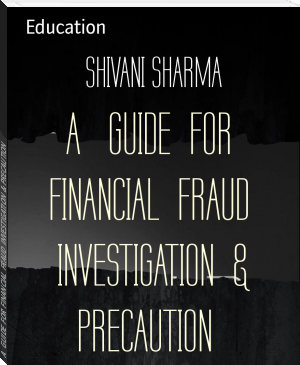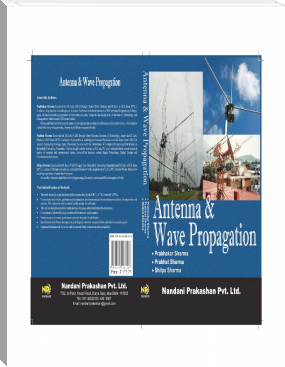A GUIDE FOR FINANCIAL FRAUD INVESTIGATION & PRECAUTION, SHIVANI SHARMA [read my book txt] 📗

- Author: SHIVANI SHARMA
Book online «A GUIDE FOR FINANCIAL FRAUD INVESTIGATION & PRECAUTION, SHIVANI SHARMA [read my book txt] 📗». Author SHIVANI SHARMA
7. Common Names and Addresses for Refunds:-Sales employees frequently make bogus refunds to customers for merchandise. The address shown for the refund is then made to the employee's address, or to the address of a friend or co-worker.
8. Increasing Reconciling Items:-Stolen deposits, or bogus checks written, are frequently not removed, or covered, from the reconciliation. Hence, over a period of time, the reconciling items tend to increase.
9. General Ledger Out-of-Balance:-When funds, merchandise, or assets are stolen and not covered by a fictitious entry, the general ledger will be out of balance. An inventory of the merchandise or cash is needed to confirm the existence of the missing assets.
10. Adjustments to Receivables or Payables:-In cases where customer payments are misappropriated, adjustments to receivables can be made to cover the shortage. Where payables are adjusted, the perpetrator can use a phony billing scheme to convert cash to his or her own use.
11. Excess Purchases:-Excess purchases can be used to cover fraud in two ways:
Fictitious payees are used to convert funds. Excessive purchases may indicate a possible payoff of purchasing agent.
12. Duplicate Payments:-Duplicate payments are sometimes converted to the use of an employee. The employee may notice the duplicate payment, then he or she may prepare a phony endorsement of the check.
13. Ghost Employees:-Ghost employee schemes are frequently uncovered when an auditor, fraud examiner, or other individual distributes paychecks to employees. Missing or otherwise unaccounted for employees could indicate the existence of a ghost employee scheme.
14. Employee Expense Accounts:-Employees frequently conceal fraud in their individual expense account reimbursements. These reimbursements should be scrutinized for reasonableness and trends, especially in the area of cash transactions on the expense account.
15. Inventory Shortages:-Normal shrinkage over a period of time can be computed through historical analysis. Excessive shrinkage could explain a host of fraudulent activity, from embezzlement to theft of inventory.
16. Increased Scrap:-In the manufacturing process, an increased amount of scrap could indicate a scheme to steal and resell this material. Scrap is a favorite target of embezzlers because it is usually subject to less scrutiny than regular inventory.
17. Large Payments to Individuals:-Excessively large payments to individuals may indicate instances of fraudulent disbursements.
18. Employee Overtime:-Employees being paid for overtime hours not worked by altering time sheets before or after management approval.
19. Write-off of Accounts Receivable:-Comparing the write-off of receivables by customers may lead to information indicating that the employee has absconded with customer payments.
20. Post Office Boxes as Shipping Addresses:-In instances where merchandise is shipped to a post office box, this may indicate that an employee is shipping to a bogus purchaser.
FORENSIC ACCOUNTINGNumerous financial frauds in the past and the beginning of the century, as well as the global financial crisis and recent scams, demanded an advanced mechanism for fraud prevention. In this scenario to cover the limitations of the existing accounting system a branch of accounting called forensic accounting came into limelight. The need for forensic accounting has been recognised worldwide and most of the developed countries are using this system very effectively and efficiently in order to fight against the white collar crimes. Unfortunately in our country the system of forensic accounting is largely unexplored and not only common people, even academicians and auditors are unaware about such an effective tool that we can use against the growing frauds and scams which are the foremost issue that India is facing at present. Chartered Accountants are the pioneers in the area of Auditing in India and they can contribute significantly to protect and prevent accounting frauds. Nowadays, criminals and fraudsters are using the latest technology and they are changing it constantly, so the new generation accountants should be updated and technically, they should be one step ahead of the criminals by upgrading themselves with the latest tools and techniques to detect financial criminology. ICAI identified this need early and has taken initiative by launching a Certificate Course on Forensic Accounting and Fraud Prevention using IT and CAAT. This paper is an attempt to show the role of Forensic Accounting in Fraud Prevention. Read on to know more....
(1)INTRODUCTION:-
According to occupational fraud and abuse (Global fraud study, 2014) Reports to Nations, issued by Association of Certified Fraud Examiners (ACFE), by the time you finish reading this sentence, the world would have lost 1.8 million dollars to fraud. Financial frauds and corruptions become a severe problem all around the world. Fraud varies from an employee reporting extra hour in duty timesheet to a minister using his power to influence someone to get any deals or contracts worth crores in favour of him. Every single amount in the account has its legal use, so misuse of any money will affect the organisation badly on where it should actually be used. The effect of this can be seen on an organisation or a nation as a whole.
It is so endemic that fraud and corruption are gradually becoming a normal way of life. In most cases scams, corruptions and financial crimes have been committed by those who are in the higher authority, who is entrusted with the responsibility of taking care of funds. If we take a look at the scams that took place in India for the last few years and the amount involved in it, it seems shocking and unbelievable. Here are a few of them:
SCAM AMOUNT COLGATE SCAM 1,86,000 CR 2G SPECTRUM SCAM 1,75,000 CR FODDER SCAM 450 CR C.R BANSALI 1,200 CR COMMON WEALTH GAMES 35,000 CR SATYAM SCANDAL 8,000 CR HARSHAT MEHTA SCAM 4,000 CR SARADA GROUP SCANDAL 40,000 CR KETAN PERAKE 1,500 CR ERON $122 MILLION WORLCOM $850 MILLION JORDAN BELFORT $200 MILLION SAM ISRAEL III $350 MILLION JOSEPH NACCHIO $3 BILLION MICHAEL DE GUZMAN $3 BILLION BARRY MINKOW $100 MILLION BERNIE MADOFF $65 BILLION
(2)Whati s Forensi Accounting?
ANS)
INTELLECTUAL PROPERTY RIGHT IN INDIA
1). Introduction:- With the advent of the knowledge and information technology era, intellectual capital has gained substantial importance. Consequently, Intellectual Property (“IP”) and rights attached thereto have become precious commodities and are being fiercely protected. In recent years, especially during the last decade, the world has witnessed an increasing number of cross-border transactions. Companies are carrying on business in several countries and selling their goods and services to entities in multiple locations across the world. Since intellectual property rights (“IPRs”) are country-specific, it is imperative, in a global economy, to ascertain and analyze the nature of protection afforded to IPRs in each jurisdiction. This paper analyzes and deals with the IP law regime in India and the protections provided thereunder.
There are well-established statutory, administrative, and judicial frameworks for safeguarding IPRs in India. It becomes pertinent to mention here that India has complied with its obligations under the Agreement on Trade Related Intellectual Property Rights (“TRIPS”) by enacting the necessary statutes and amending the existing statues. Well-known international trademarks have been afforded protection in India in the past by the Indian courts despite the fact that these trade marks were not registered in India. Computer databases and software programs have been protected under the copyright laws in India and pursuant to this; software companies have successfully curtailed piracy through judicial intervention. Although trade secrets and know-how are not protected by any specific statutory law in India, they are protected under the common law. The courts, under the doctrine of breach of confidentiality, have granted protection to trade secrets.
2) Legislation:- The Trade and Merchandise Marks Act, 1958 (“TM Act, 1958”) has been replaced by the Trade Marks Act, 1999, The Copyright Act, 1957 has been amended to protect computer programs as “literary work”; The Patent Act, 1970 has been amended by the Amendment Acts of 1999 and 2002 and 2005. The Designs Act of 1911 has been completely replaced by the Designs Act of 2000. The following laws have been enacted to protect newly recognized species of intellectual property in India:
■ The Geographical Indications of Goods (Registration and protection) Act, 1999;
■ The Semiconductor Integrated Circuits LayoutDesign Act, 2000;
■ The Protection of Plants & Varieties and Farmers Rights Act, 2001; and
■ The Biological Diversity Act, 2002 These acts, and particularly the impact of recent amendments to the acts, are discussed in greater detail in the ensuing sections.
3) Trademarks:- In India, trademarks are protected both under statutory law and common law. The Trade and Merchandise Marks Act, 1940 (“TM Act, 1940”) was the first law in this regard in India, which was replaced later by the TM Act, 1958. The Trade Marks Act, 1999 (“TM Act”) - which has replaced the TM Act, 1958 - came into effect on September 15, 2003 and is in compliance with the TRIPS obligations. The TM Act allows for the registration of service marks and three-dimensional marks as well. India follows the NICE Classification of goods and services, which is incorporated in the Schedule to the Rules under the TM Act.1 A Trade Marks Registry had been established for the purposes of the TM Act, 1940, which has continued to function under the TM Act, 1958 and TM Act. The Trade Marks Registry is under the charge of the Registrar of Trademarks. The head office of the Trade Marks Registry is in Bombay (Mumbai) and its branches are at Calcutta (Kolkata), Delhi, Madras (Chennai), and Ahmedabad. The territorial jurisdiction of each office has also been allocated.
In addition to trademarks, the following categories of marks can also be registered under the TM Act:
■ Certification marks are given for compliance with defined standards, but are not confined to any membership. Such marks are granted to anyone who can certify that the products involved meet certain established standards. The internationally accepted “ISO 9000” quality standard is an example of a widely recognized certification mark.
■ Collective marks can be owned by any association. The members of such associations will be allowed to use the collective mark to identify themselves with a level of quality and other requirements and standards set by the association. Examples of such associations would be those representing accountants, engineers or architects.
I. Unconventional





Comments (0)